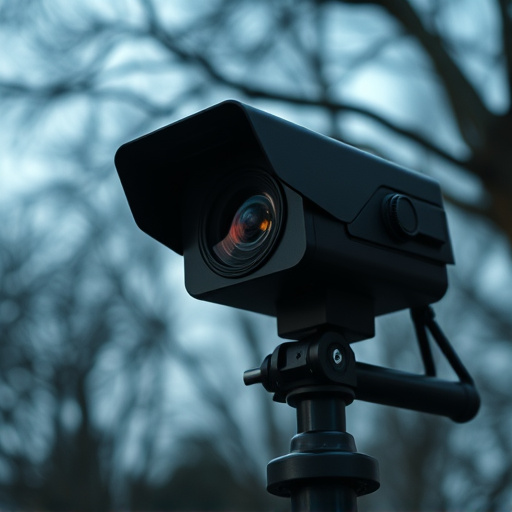To prevent motion-activated camera false alarms, follow these guidelines: strategically place cameras with clear lines of sight, avoiding areas prone to mistaken triggers like shadows or pets. Use models with advanced sensors and adjustable sensitivity settings, and consider different motion detection technologies. For indoor spaces, mount at high or low angles; outdoors, position above ground level and clear of obstructions. Employ creative mounting strategies using flexible mounts or adjustable brackets to reduce unwanted trip triggers. Invest in weatherproof housing for outdoor cameras to protect from extreme weather and minimize glare-caused false alarms. Regularly maintain cameras by testing, cleaning, and checking battery life and connectivity to ensure optimal performance and reduce false alert occurrences.
“Uncover the secrets to discreetly securing your space with concealed security camera mounting. This comprehensive guide explores the art of integrating surveillance technology seamlessly into your environment while minimizing false alarm risks. From understanding motion-activated cameras’ intricacies to selecting the perfect mounting locations, this article equips readers with insights for optimal performance. Learn effective techniques to reduce unwanted trip triggers and choose weatherproof housing for outdoor cameras, ensuring peace of mind in any setting.”
- Understanding Motion Activated Cameras and False Alarms
- Choosing the Right Location for Discreet Mounting
- Mounting Techniques to Reduce Unwanted Trip Triggers
- Selecting Weatherproof Housing for Outdoor Cameras
- Regular Maintenance: Ensuring Optimal Performance and Reduced False Alerts
Understanding Motion Activated Cameras and False Alarms
Motion activated cameras are a popular choice for home and business security due to their ability to capture footage only when motion is detected, enhancing surveillance efficiency. However, they can also be prone to false alarms, which not only waste valuable time but can also lead to unnecessary stress and potential privacy concerns. To minimise false alarm prevention, it’s crucial to strategically place these cameras in areas with clear lines of sight, avoiding shadows or areas where pets, passing vehicles, or environmental factors might trigger the sensor mistakenly.
Selecting the right motion activated camera models designed with advanced sensors and adjustable sensitivity settings can significantly reduce false alarms. Understanding the different types of motion detection technologies—like passive infrared (PIR), active infrared, and digital signal processing—helps in choosing the most suitable camera for specific environments. Regular maintenance and testing also play a vital role in ensuring these cameras function accurately, offering a more reliable security solution.
Choosing the Right Location for Discreet Mounting
When mounting a security camera, discretion is key, especially for motion-activated models to prevent false alarms. The best location offers clear sightlines while remaining out of plain view. For indoor spaces, consider high or low angles that capture critical areas without appearing obtrusive. Ceilings, walls, or even fake smoke detectors can provide optimal positioning.
Outdoor setups require careful consideration of surroundings and potential obstacles. Trees, buildings, or other structures should not obstruct the camera’s field of view. Ensure the mounting surface is sturdy enough to support the device securely while keeping it as low as possible to reduce the risk of false activations from passing animals or insects.
Mounting Techniques to Reduce Unwanted Trip Triggers
To minimize false alarm prevention with motion-activated cameras, consider creative mounting techniques that can reduce unwanted trip triggers. One effective method is to position the camera at a slight angle, allowing it to capture movement without being directly triggered by small objects or innocent passersby. This subtle adjustment can significantly cut down on false alerts.
Additionally, using flexible mounts or adjustable brackets enables precise placement, ensuring the camera focuses on specific areas of interest while avoiding common trip points. By strategically positioning the device higher up or at an angle that bypasses frequent obstacles, you can enhance its accuracy and reduce false alarm rates. These mounting techniques are essential for maintaining reliable surveillance without unnecessary disruptions.
Selecting Weatherproof Housing for Outdoor Cameras
When mounting security cameras outdoors, selecting a weatherproof housing is paramount. This crucial step ensures your motion-activated camera can withstand varying weather conditions, from pouring rain to scorching sun, without succumbing to damage or malfunction. Look for housings made of robust materials like durable plastic or metal, sealed tightly to prevent water intrusion and ensure optimal performance.
To minimise false alarm prevention, consider a housing designed with protective features such as IR cut filters that reduce glare from artificial lighting at night, preventing accidental triggers. Additionally, some models offer adjustable mounting options, allowing you to position the camera strategically to avoid unnecessary alerts. This thoughtful design promotes both clear visuals and reliable operation, even in challenging outdoor environments.
Regular Maintenance: Ensuring Optimal Performance and Reduced False Alerts
Regular maintenance is a key component in ensuring your concealed security camera system functions at its best and minimizes false alert occurrences. By regularly testing and cleaning the cameras, you can prevent debris buildup that might obstruct the lens or impact image quality. Additionally, checking the battery life and connectivity ensures that the system remains operational and alerts are transmitted effectively without interruption.
A well-maintained motion-activated camera is less likely to trigger false alarms due to environmental factors or innocent movements. This prevents unnecessary distress for homeowners and saves on potential surveillance costs. Regularly reviewing footage can also help identify patterns in false alert triggers, allowing you to adjust sensitivity settings or make necessary changes to the camera’s placement for more accurate activation.
In conclusion, successful implementation of concealed security camera systems involves a thoughtful approach to motion activated cameras and false alarm prevention. By strategically choosing mounting locations, employing techniques to minimize unwanted trip triggers, selecting robust weatherproof housing for outdoor cameras, and conducting regular maintenance, you can ensure optimal performance while significantly reducing false alerts. These recommendations cater to both residential and commercial settings, enhancing security without compromising aesthetics or causing nuisance.
